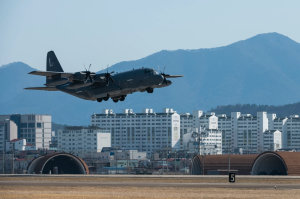North Korea fired two short-range ballistic missiles (SRBMs) toward its east coast on Monday, according to South Korea’s Joint Chiefs of Staff (JCS). The missile was launched from the Chunghwa area in North Hwanghae Province, around 7:47 a.m. KST, and flew about 370 kilometers.
Eight days after the North fired an SRBM as a part of its “tactical nuclear attack drill,” it resumed launching ballistic missiles as South Korea and the United States carried out their large-scale Ssangyong exercise, a joint amphibious landing drill, from March 20. The drill will end on April 3.
South Korean and U.S. intelligence authorities are analyzing the performance of North Korea’s latest SRBMs.
During the Freedom Shield exercise, the regular springtime South Korea-U.S. joint military drills held from March 13 to March 23, North Korea actively took tit-for-tat measures in a bid to frame the drills as a war provocation raising the risk of nuclear war in the region. In the past two weeks, North Korea fired its Hwasong-17 intercontinental ballistic missile (ICBM) as well as short-range ballistic missiles. The day after Freedom Shield concluded, North Korea claimed that it had tested a new “unmanned underwater nuclear attack craft.” It also showed off its missile capabilities by launching “strategic cruise missiles” from a submarine on March 12.
Throughout this period, North Korean state media constantly released statements from Pyongyang officials demanding that the United States and South Korea immediately halt their joint military drills, while threatening to initiate a nuclear-based response for self-defense.
According to South Korean military officials, the Ssangyong exercise, the first of its kind since 2018, will be carried out on the division level on the basis of the agreements to scale up the drill. The exercises will involve about 70 aircraft, 30 vessels and 50 amphibious assault vehicles. In addition to South Korea-U.S. landing forces, about 40 British Marines also participated in the exercise for the first time.
Monday’s SRBM launch was carried out a day before the U.S. nuclear-powered aircraft carrier, USS Nimitz, enters Busan Naval Base to stage drills and commemorate the 70th anniversary of the South Korea-U.S. alliance, according to the South Korean Defense Ministry.
Considering the scale and nature of the Ssangyong exercise, North Korea will likely respond by launching more ballistic missiles. Seoul and Washington’s military drills will likely be a strong motivation for the North to continue illicit ballistic launches as a response – especially since South Korea reinstated its three-axis system, which consists of three different steps in coping with the North’s nuclear attack since South Korean President Yoon Suk-yeol took office in May 2022. The three axis system includes both preemptive strikes to intercept North Korean missiles and – should Pyongyang successfully attack the South – “massive punishment and retaliation,” which would included strikes designed to kill leader Kim Jong Un.
At this stage, North Korea appears to have no choice but to stick with its old-school brinkmanship strategy to confront the reinvigorated South Korea-U.S. joint military drills as Seoul and Washington are also not in a hurry to resume the stalled nuclear talks. This year, South Korea and the United States agreed to hold more joint military drills involving substantive simulations to grapple with the North Korean nuclear threats.
North Korea will actively seek ways to strengthen cooperation with China and Russia while aggravating the security instability on the Korean Peninsula with ballistic missile tests. As Kim Jong Un made clear that his nuclear weapons will not be on the bargaining table in future nuclear talks, the arms race in the region will be intensified while no one stepping on the brake.

































